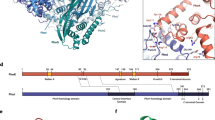Abstract
Diphthamide, the target of diphtheria toxin, is a post-translationally modified histidine residue found in archaeal and eukaryotic translation elongation factor 2 (EF2). In the first step of diphthamide biosynthesis, a [4Fe–4S] cluster-containing radical SAM enzyme, Dph1–Dph2 heterodimer in eukaryotes or Dph2 homodimer in archaea, cleaves S-adenosylmethionine and transfers the 3-amino-3-carboxypropyl group to EF2. It was demonstrated previously that for the archaeal Dph2 homodimer, only one [4Fe–4S] cluster is necessary for the in vitro activity. Here, we demonstrate that for the eukaryotic Dph1–Dph2 heterodimer, the [4Fe–4S] cluster-binding cysteine residues in each subunit are required for diphthamide biosynthesis to occur in vivo. Furthermore, our in vitro reconstitution experiments with Dph1–Dph2 mutants suggested that the Dph1 cluster serves a catalytic role, while the Dph2 cluster facilitates the reduction of the Dph1 cluster by the physiological reducing system Dph3/Cbr1/NADH. Our results reveal the asymmetric functional roles of the Dph1–Dph2 heterodimer and may help to understand how the Fe–S clusters in radical SAM enzymes are reduced in biology.






Similar content being viewed by others
References
Van Ness BG, Howard JB, Bodley JW (1980) J Biol Chem 255:10710
Collier RJ (2001) Toxicon 39:1793
Chen C-M, Behringer RR (2005) Curr Opin Genet Dev 15:49
Su X, Lin Z, Lin H (2013) Crit Rev Biochem Mol Biol 48:515
Schaffrath R, Abdel-Fattah W, Klassen R, Stark MJ (2014) Mol Microbiol 94:1213
Tsuda-Sakurai K, Miura M (2019) J Biochem 165:1
Dong M, Zhang Y, Lin H (2018) Biochemistry 57:3454
Lin Z, Su X, Chen W, Ci B, Zhang S, Lin H (2014) J Am Chem Soc 136:6179
Su X, Chen W, Lee W, Jiang H, Zhang S, Lin H (2012) J Am Chem Soc 134:773
Su X, Lin Z, Chen W, Jiang H, Zhang S, Lin H (2012) Proc Natl Acad Sci USA 109:19983
Uthman S, Bar C, Scheidt V, Liu S, ten Have S, Giorgini F, Stark MJ, Schaffrath R (2013) PLoS Genet 9:e1003334
Dong M, Su X, Dzikovski B, Dando EE, Zhu X, Du J, Freed JH, Lin H (2014) J Am Chem Soc 136:1754
Zhang Y, Zhu X, Torelli AT, Lee M, Dzikovski B, Koralewski RM, Wang E, Freed J, Krebs C, Ealick SE, Lin H (2010) Nature 465:891
Dong M, Kathiresan V, Fenwick MK, Torelli AT, Zhang Y, Caranto JD, Dzikovski B, Sharma A, Lancaster KM, Freed JH, Ealick SE, Hoffman BM, Lin H (2018) Science 359:1247
Zhu X, Dzikovski B, Su X, Torelli AT, Zhang Y, Ealick SE, Freed JH, Lin H (2011) Mol BioSyst 7:74
Dong M, Horitani M, Dzikovski B, Pandelia ME, Krebs C, Freed JH, Hoffman BM, Lin H (2016) J Am Chem Soc 138:9755
Lin Z, Dong M, Zhang Y, Lee EA, Lin H (2016) Nat Chem Biol 12:995
Broderick JB, Duffus BR, Duschene KS, Shepard EM (2014) Chem Rev 114:4229
Acknowledgements
This work was supported by grants from the National Institutes of Health National Institute of General Medical Sciences GM088276 to H.L.
Author information
Authors and Affiliations
Corresponding author
Additional information
Publisher's Note
Springer Nature remains neutral with regard to jurisdictional claims in published maps and institutional affiliations.
Rights and permissions
About this article
Cite this article
Dong, M., Dando, E.E., Kotliar, I. et al. The asymmetric function of Dph1–Dph2 heterodimer in diphthamide biosynthesis. J Biol Inorg Chem 24, 777–782 (2019). https://doi.org/10.1007/s00775-019-01702-0
Received:
Accepted:
Published:
Issue Date:
DOI: https://doi.org/10.1007/s00775-019-01702-0




